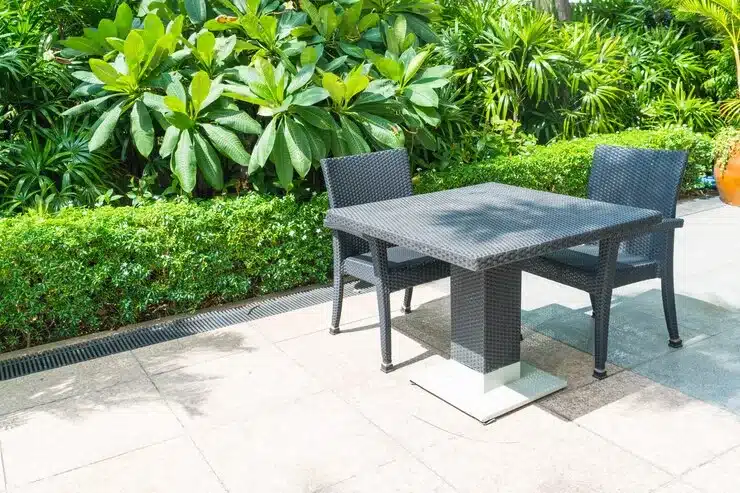
The patio is an extension of the home. It is a place to relax, entertain, and enjoy the outdoors. For many homeowners, the patio is one of the most used areas on the property. If you’re considering upgrading your patio, concrete is an excellent option.
Concrete is durable, low maintenance, and aesthetically pleasing. In this article, we’ll explore the top seven reasons why a concrete patio is a smart choice for your home.
From practical benefits like longevity and low upkeep to attractive features like the ability to stamp and stain concrete, you’ll learn why concrete is a top pick for patios.
What Is a Concrete Patio?
A concrete patio refers to an outdoor flooring area constructed from poured concrete. Concrete patios provide a durable, low-maintenance area for outdoor living and entertaining. The concrete is poured over a gravel base and then smoothed and stamped to the homeowner’s specifications regarding shape, texture, and color.
Durability
Concrete patios are extremely durable and long-lasting. Properly poured and cured concrete can last 30-50 years with minimal maintenance required. Concrete is not damaged by exposure to weather and elements like wood or stone. It will not rot, warp, or crack over time. Concrete also resists stains, scratches, dents, and damage from insects or pets.
Low Maintenance
A concrete patio requires very little maintenance to keep it looking new. Occasional sweeping or hosing off is typically all that is needed. Concrete patios do not need to be stained or sealed and will not fade or stain over time from spills or weather. Repairs are also easy to patch and blend in with the existing surface.
Design Flexibility
Concrete patios offer a lot of flexibility in shape, size, and appearance. They can be poured to fit any space and in curves or geometric shapes to complement the architecture and landscape. Concrete can also be textured, stamped, or stained in a variety of patterns and colors to achieve a custom look. Pavers, inlays, stencils, or paints can also be used to embellish the surface.
With the durability, low maintenance, and design flexibility of a concrete patio, it is easy to see why it remains such a popular choice for outdoor living spaces. Creating an inviting patio area for relaxing and entertaining extends the living space and enhances the enjoyment of any home.
Top 7 Reasons to Choose Concrete for Your Patio
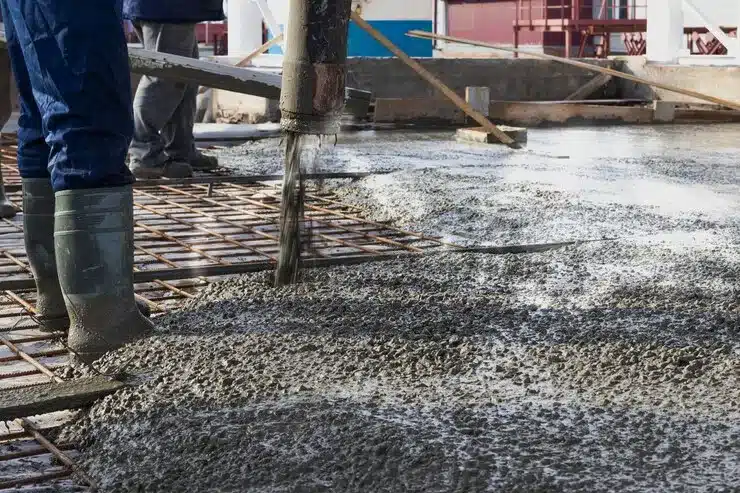
Concrete patios are a popular choice for homeowners due to several beneficial attributes.
Durability and Longevity
Concrete patios are extremely durable and long-lasting. Properly installed concrete can last for decades with minimal maintenance required. Concrete patios are not susceptible to rot, decay, or insect damage like wood patios. They also withstand weathering and environmental exposure better than most other materials.
Low Maintenance
Concrete patios require very little maintenance to keep them looking attractive. An occasional sweeping or hosing off to remove debris is typically all that is needed. Concrete patios do not require staining, painting, or waterproofing like other materials.
Customizable and Attractive
Concrete patios can be customized in many ways to complement a home’s architecture and style. Concrete can be stamped, colored, stained or painted. Aggregates can also be mixed in to create stone or tile effects. These custom options allow for a very attractive and unique patio space.
Safety
A concrete patio provides a stable, even surface which reduces the risk of trips and falls. It also does not splinter, warp, or buckle like wood. Properly installed railings provide an added safety measure for elevated patio spaces.
Affordability
Concrete patios are very budget-friendly. The materials and installation costs for a basic concrete patio are typically lower than other options like brick, stone, or tile. The longevity and low maintenance of concrete also provide good long-term value.
Stability
Concrete patios provide a solid, stable base due to the weight and density of the material. They do not shift, sink, or become uneven over time like some other materials. This stability is important for furniture, recreational equipment, and high-traffic patio spaces.
Easy to Repair and Replace
If damage does occur to a concrete patio, repairs or replacement sections can typically be made easily by patching damaged areas or pouring new sections. Concrete patios can often be repaired and restored more affordably than reconstructing an entire patio.
Designing Your Dream Concrete Patio
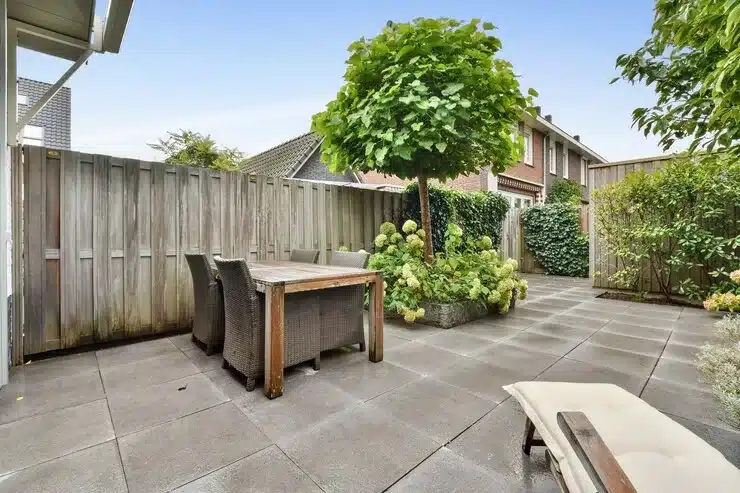
When designing a concrete patio, homeowners have numerous options to consider regarding size, shape, and features. The patio can be a simple square or circle, or incorporate curves and angles for a more custom look. Determining the dimensions depends on the available space and how the area will be used. A patio intended mainly for dining and entertaining may require a larger size, perhaps 15 by 20 feet or more. One meant primarily for relaxation could be 10 by 12 feet.
Shape and Size
The shape and size of the concrete patio should complement the home’s architecture and landscape. Rounded shapes like circles or ovals tend to appear more natural, while squares and rectangles align better with traditional home styles. Once the basic shape is determined, consider adding visual interest with rounded edges or cut-out areas. When space allows, offsetting the patio from the house creates an area for plantings or a walkway.
Surface Texture
Applying a surface texture to the concrete provides additional style and safety. A broom finish, stamped or imprinted pattern, or exposed aggregate are popular options. A broom finish, with its subtle sweeping pattern, offers traction without being too rough. Stamped concrete can mimic stone, tile, or brick for an elegant look. Exposed aggregate exposes the gravel and stones in the concrete for a highly textured finish. Any texture should be applied before the concrete fully hardens.
Other Features
For comfort and convenience, incorporate other features into the design like seating walls, steps, planters, or lighting. Low seating walls around the edges of the patio provide extra seating space. Steps leading down to a lawn or garden help transition between areas. Planters filled with colorful flowers or greenery soften the hard edges of concrete. Strategically placed lighting fixtures illuminate the patio for evening use and highlight special features.
With some thought and planning, a concrete patio can be designed to meet both practical and aesthetic needs. Homeowners have many options to create an inviting and stylish outdoor living space customized to their tastes.
Maintaining and Caring for a Concrete Patio
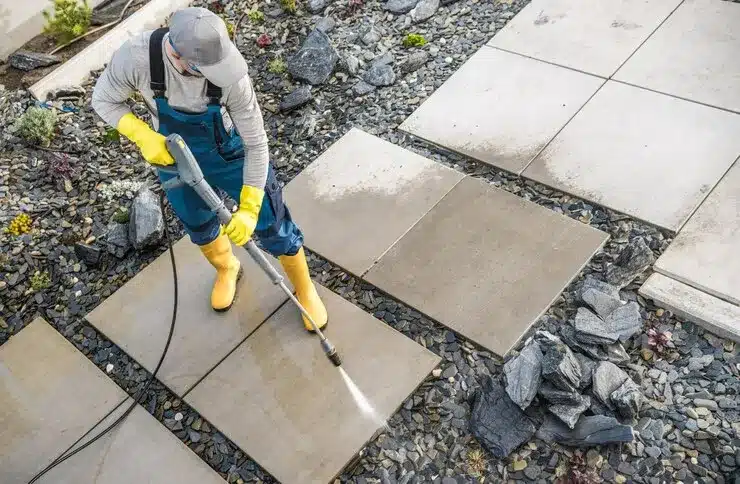
Maintaining a concrete patio requires minimal effort but consistent care and cleaning. Concrete patios are durable and long-lasting if properly cared for. Regular maintenance includes sweeping debris, pressure washing, and resealing the concrete.
Sweeping and Cleaning
It is important to routinely sweep concrete patios to remove dirt, leaves, and other debris. Monthly sweeping or blowing with a leaf blower is typically sufficient for most homeowners. For stuck-on messes, a degreaser or concrete cleaner can be used according to the product directions. Scrubbing too aggressively can damage the surface sealant or paint.
Pressure Washing
Over time, mold, mildew, and grime can build up on concrete patios. Pressure washing with a commercial concrete cleaner or degreaser once a year or every other year will remove surface stains and refresh the appearance. The pressure washer should be kept at least 4 to 6 feet from the surface using a wide spray pattern. Harsher pressure or closer proximity can damage the concrete.
Sealing
Applying a concrete sealant every 2 to 3 years will help protect the surface from stains and moisture damage. Acrylic or epoxy sealants can be rolled or sprayed on and provide a durable, water-resistant coating. The sealant may darken the concrete slightly but will prevent fading over time from weather and sun exposure. Proper sealing is especially important for stamped or stained concrete patios.
With regular maintenance, a concrete patio can provide many years of outdoor entertainment space and add value to a home. Keeping the area clear of debris and properly sealed will ensure maximum durability and appearance. Annual pressure washing and resealing are a small investment to protect such a long-lasting backyard fixture.
Concrete Patio FAQs
Concrete patios are extremely durable and long-lasting. Properly installed and maintained concrete patios can last 30-50 years or more. The lifespan depends on several factors like the quality of concrete used, installation techniques, and environmental factors like weather and usage. High-quality, reinforced concrete with air entrainment additives and proper sealing can significantly increase the longevity of a concrete patio.
The cost of a concrete patio installation depends on several factors the size, shape, thickness, and additional features of the patio. On average, a standard rectangular concrete patio costs between $6 to $20 per square foot. More complex patios with curved shapes, patterns, or thicker concrete can cost $30 per square foot or more. Additional costs may include permits, excavation, reinforcement, and sealing. In general, homeowners can expect to pay between $3,000 to $30,000 for a concrete patio depending on the specifications.
Yes, concrete patios can be stained or stamped to enhance their appearance. Staining a concrete patio involves applying colorants to the surface that soak into the concrete, highlighting the texture. Stamping involves impressing patterns into the concrete before it hardens to create stone, brick, or tile textures. Staining and stamping are popular ways to customize the look of a concrete patio and make it match a home’s style or architecture. These decorative techniques do require additional costs, equipment, and expertise to achieve professional results.
While concrete patios are durable, they do require some basic maintenance to maximize their lifespan. It is recommended to seal concrete patios every 3-5 years to protect from water damage and stains. Brooming or power washing the patio annually will remove dirt and debris. Periodic inspections should check for any cracks or damage and repair as needed. Re-staining or re-stamping may be required every 5-10 years depending on weathering. With proper sealing and minor maintenance, a concrete patio can provide many years of outdoor enjoyment.
Conclusion
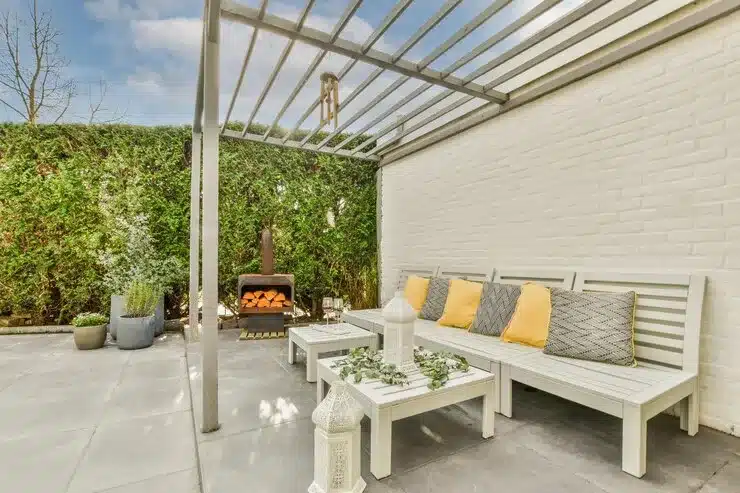
Installing a concrete patio in your backyard can provide numerous benefits that enhance your outdoor living space. With proper maintenance, a concrete patio will last for decades and provide an extremely durable and attractive area for gatherings and recreation. The smooth, solid surface is ideal for the placement of patio furniture, barbecues, and other amenities.
Compared to materials like wood, a concrete patio requires less upkeep while still allowing for creative design through shape, texture, and color choices. Weighing the pros and cons, a concrete patio is a home improvement that can increase the enjoyment of your yard for years to come. With smart preparation and design, you can create an outdoor concrete oasis perfect for relaxation and entertainment.
At Rhino Concrete Danville, our team comprises expert concrete technicians and craftsmen who bring together decades of combined experience. These professionals excel in forming, pouring, and finishing concrete, ensuring the creation of patios that are not only aesthetically pleasing but also built to last. By keeping abreast of the latest techniques and technologies in the industry, they guarantee top-notch results for our clients, emphasizing quality and durability in every project.






